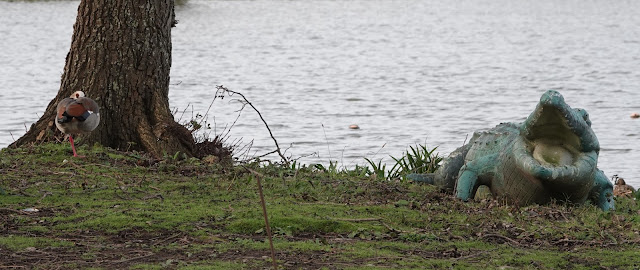A www.blueeyedbirder.com adventure:
A day out down the Suffolk coast saw us meeting at North Warren at 9am and even managing to get three cars into the free car parking spot! A Great White Egret greeted us within a couple of minutes as it flew steadily north and I could hear the Barnacle Geese somewhere out in the meadows.
We slowly walked down between the Blackthorn hedge where
Antony quickly found the ‘fashionable to find’ fly mine Phytobia cerasiferae
within the stems. This species and one
in Hawthorn have gone from being almost unknown to being added to many vice
counties across the UK and even added to Belgian and Eire national lists after
Barry Warrington suggested we should all go out and look for them both!
 |
| Feeding signs of Phytobia cerasiferae |
The Barnacle Goose flock was feeding unconcerned close to
the path and did us a favour as amongst them were the Russian White-fronts and
as the Barnies did not move away, neither did they. There were a good number of juveniles amongst
the 111 that I counted.
 |
| Barnacle Geese & Russian White-fronts |
Flocks of Teal and Wigeon were out on the floods and many
Rooks and a few Lapwing and Curlew probed the pastures where a smart Water
Pipit was pecking around the pool edges.
A flock of Meadow Pipits played hide and seek and a single Skylark
called.
 |
| Water Pipit - Antony Wren |
Retracing our steps so as not to spook the Geese by going
closer, we then walked down the road to the second viewing screen adding a few
more waterbirds that included a flock of about 300 Pintail that performed an
elegant circuit of the marsh. The
conditions here must be just right to attract such a number.
 |
| Pintail |
The walk back added a smart adult male Marsh Harrier and a
hovering Kestrel before we drove down through Aldeburgh town to check for the
always absent Glossy Ibis which we succeeded in not seeing with aplomb! It was bitterly cold and quite breezy down
there and after seeing a few Scoter and Red-throated Divers off shore, we
headed back north to Thorpeness for the similarly elusive drake Ring-necked
Duck on the Meare.
It took Antony all of ten seconds to find him paddling
across the middle, gleaming in black, white and grey before tucking himself into
the bank and nodding off. Three male and
two female Goosander were loafing around but there were no other diving duck whatsoever
amongst the Shoveler, Teal, Mallard and Gadwall.
 |
| Ring-necked Duck - Antony Wren |
 |
| Egyptian Goose feeling at home with a Nile Crocodile |
 |
| World's most distant Kingfisher |
 |
| Annual or Small Nettle - Urtica urens |
Coffee and a sausage roll lured us into the tea room from
where we could still see the RND albeit from a slightly warmer position.
Feeling a little more human we moved up to Westleton Heath
where we hoped that despite the lack of sun and now, almost still conditions
that heathland birds would abound. They
did not and it was, not for the first time, disturbingly quiet. We heard a Blackbird, a Blue Tit and a Great
Spotted Woodpecker and actually got quite excited to glimpse a Robin!
Minotaur Beetle burrows were plentiful and I counted 39 on our circuit while Antony poked around for early moth signs and found a rare Coleophora on Oak buds.
 |
| Minotaur Beetle burrow |
 |
| Orange Brain - Witch's Butter |
 |
| Muntjac - a youngster - look at those mega blackberry eyes! |
 |
| Phytomyza ilicis |
 |
| Coleophora lutipennella - still not sure how Antony found this |
A quick lunch and then on to Southwold to look for the
Lesser Yellowlegs little knowing that it had been seen in the pig fields inland
at Blythburgh. We still had a pleasant if somewhat chilly walk down to the
harbour and found over 100 Snipe on the shallow flooded fields along with a few
Curlew, Redshank, Dunlin and Black-tailed Godwits.
Cetti’s chattered and the Barnacle Geese were tucked over
the back. With no ’Legs, we headed back
and still had time for a relaxed sit at Hen Reedbeds as the light fell. No Bitterns emerged but the Marsh Harriers
were close quartering the reedbeds and nearly 40 Pied Wagtails dropped into
roost. In the distance a huge snaky amorphous
blob of about 10,000 Starlings wiggled north but certainly did not circle
around to the reedbeds before we called it a night.
 |
| Starlings |
Squealing Water Rails and ‘tsipping’ Redwings accompanied us back to the cars.

















No comments:
Post a Comment